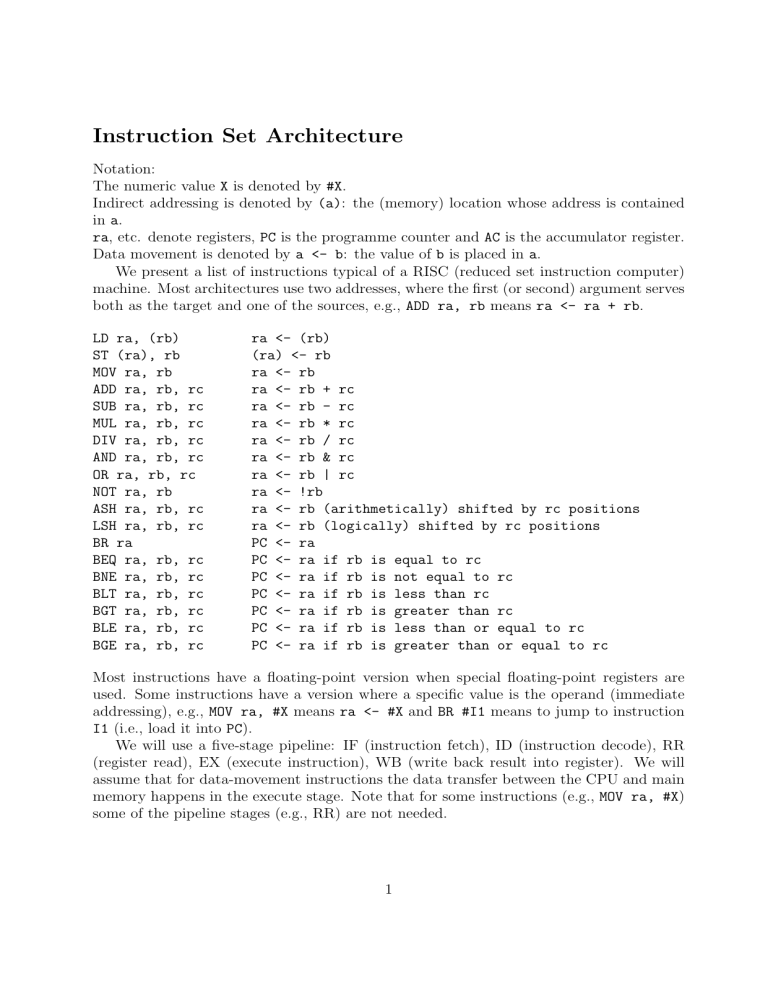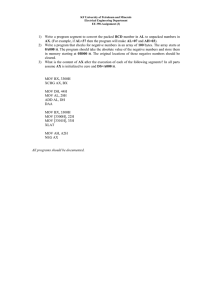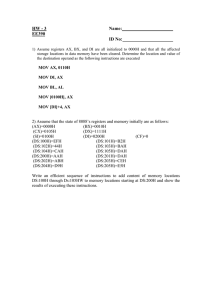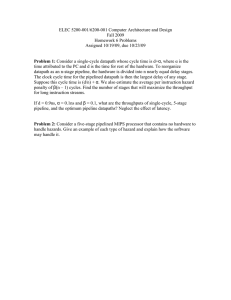ISA

Instruction Set Architecture
Notation:
The numeric value X is denoted by #X .
Indirect addressing is denoted by (a) : the (memory) location whose address is contained in a .
ra , etc. denote registers, PC is the programme counter and AC is the accumulator register.
Data movement is denoted by a <- b : the value of b is placed in a .
We present a list of instructions typical of a RISC (reduced set instruction computer) machine. Most architectures use two addresses, where the first (or second) argument serves both as the target and one of the sources, e.g., ADD ra, rb means ra <- ra + rb .
LD ra, (rb)
ST (ra), rb
MOV ra, rb
ADD ra, rb, rc
SUB ra, rb, rc
MUL ra, rb, rc
DIV ra, rb, rc
AND ra, rb, rc
OR ra, rb, rc
NOT ra, rb
ASH ra, rb, rc
LSH ra, rb, rc
BR ra
BEQ ra, rb, rc
BNE ra, rb, rc
BLT ra, rb, rc
BGT ra, rb, rc
BLE ra, rb, rc
BGE ra, rb, rc ra <- (rb)
(ra) <- rb ra <- rb ra <- rb + rc ra <- rb - rc ra <- rb * rc ra <- rb / rc ra <- rb & rc ra <- rb | rc ra <- !rb
ra <- rb (arithmetically) shifted by rc positions ra <- rb (logically) shifted by rc positions
PC <- ra
PC <- ra if rb is equal to rc
PC <- ra if rb is not equal to rc
PC <- ra if rb is less than rc
PC <- ra if rb is greater than rc
PC <- ra if rb is less than or equal to rc
PC <- ra if rb is greater than or equal to rc
Most instructions have a floating-point version when special floating-point registers are used. Some instructions have a version where a specific value is the operand (immediate addressing), e.g., MOV ra, #X means ra <- #X and BR #I1 means to jump to instruction
I1 (i.e., load it into PC ).
We will use a five-stage pipeline: IF (instruction fetch), ID (instruction decode), RR
(register read), EX (execute instruction), WB (write back result into register). We will assume that for data-movement instructions the data transfer between the CPU and main memory happens in the execute stage. Note that for some instructions (e.g., MOV ra, #X ) some of the pipeline stages (e.g., RR) are not needed.
1
Example
Write an assembly program that computes (((10 ∗ 8) + 4) − 7) 2 and show the delay slots when executed on a five-stage pipeline. Try to minimize the number of registers used.
We make the following assumptions:
1. Instructions are executed in the order they appear in the code.
2. Instructions like MOV r1, #10 skip the RR and WB stages.
3. If an instruction cannot be further processed (because of some dependency) then it stalls the pipeline.
Here is the code:
I1 MOV r1, #10
I2 MOV r2, #8
I3 MUL r1, r1, r2
I4 MOV r2, #4
I5 ADD r1, r1, r2
I6 MOV r2, #7
I7 SUB r1, r1, r2
I8 MUL r1, r1, r1
Here is the diagram showing delay slots:
1 2 3 4 5 6 7 8 9 10 11 12 13 14 15 16
IF I1 I2 I3 I4 I5 I5 I6 I7 I7 I8
ID I1 I2 I3 I4 I4 I5 I6 I6 I7 I8 I8 I8
RR I3 I5 I7
EX
WB
I1 I2 I3 I4
I3
I5 I6
I5
I7
I7
I8
I8
I8
2
Exercise
Consider the computation ( M 1 ∗ M 2) + M 3 − M 4 where M i indicates the content of a memory location. Write an assembly program for the above computation using minimum number of registers. Show the delay slots when the code is executed on a five-stage pipeline.
You can make the following assumptions:
1. Instructions are executed in the order they appear in the code.
2. Instructions like MOV r1, M1 skip the RR stage.
3. There is an internal cache where decoded instructions can be stored until they can be further processed.
Comprehensive Exercise
Consider the computation ( M 1 ∗ M 2) + ( M 3 ∗ M 4).
1. Write a program in assembly language that performs the above computation. Try to use a minimal number of registers (assume that initially all registers contain 0).
2. Draw a diagram showing the execution of your program in a five-stage pipeline using in-order-issue in-order-completion.
3. Identify the dependencies in your code.
4. Draw a diagram showing the execution of your program in a five-stage pipeline using in-order-issue out-of-order-completion.
5. Remove as many dependencies as possible from your code (by using register renaming) and reorder the code to minimize the number of delay slots when executed on a five-stage pipeline. Show the pipeline activity in a diagram.
You can assume that there is no resource conflict between fetching an instruction and executing a data transfer instruction.
3




